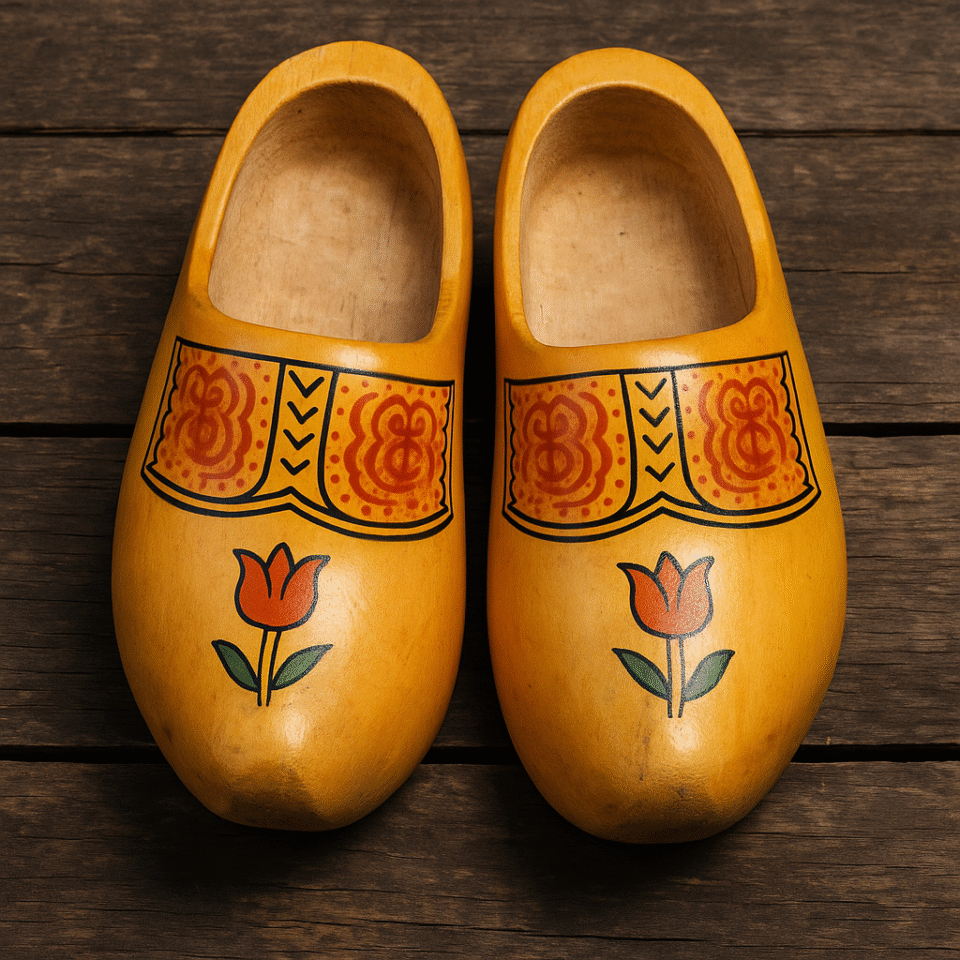Ever browsed photos of the Netherlands and wondered about those distinctive wooden shoes displayed in every tourist shop? Or perhaps you’ve seen videos of Dutch dancers performing in what sounds like percussion instruments strapped to their feet? For many Americans curious about Dutch culture, klompen (Dutch wooden shoes) might seem like little more than tourist trinkets—quaint relics from a bygone era. Yet these humble wooden clogs tell a fascinating story about Dutch ingenuity, practicality, and the unique landscape that shaped a nation’s footwear.
If you’re considering a move to the Netherlands or simply fascinated by Dutch culture, understanding the actual history and cultural significance of klompen offers more than trivia—it provides insight into the practical mindset that continues to influence Dutch design and problem-solving today.
The Practical Origins of Dutch Wooden Shoes
Contrary to popular belief, wooden shoes weren’t invented as some quirky fashion statement. Klompen emerged as a brilliant solution to a very Dutch problem: how to keep your feet dry and protected when much of your country sits below sea level.
Dating back to the 13th century (though some evidence suggests even earlier origins), wooden shoes developed as a practical response to the Netherlands’ notoriously wet, muddy terrain. Unlike leather boots, which would quickly deteriorate in constantly damp conditions, wooden shoes remained water-resistant, durable, and—crucially—affordable for the average farmer or fisherman.
The earliest klompen were entirely handcrafted from willow or poplar wood, chosen specifically for being lightweight while still durable. A skilled craftsman (known as a klompenmaker) could transform a log into a comfortable, functional shoe using specialized tools like the block knife and hollowing spoon.
Engineering Brilliance in Simple Form
What might surprise you is the ergonomic intelligence behind klompen design. These weren’t crude wooden blocks but carefully engineered footwear:
- The hollow interior was precisely carved to match foot contours
- The elevated heel and toe design kept feet above wet ground
- The rocker-shaped bottom facilitated natural walking motion
- The wide design distributed weight evenly on soft terrain
- The enclosed top protected against falling objects in work environments
In essence, klompen represent early occupational safety equipment—protective gear for workers long before steel-toed boots existed. They protected farmers from cow hooves, fishermen from hooks, and factory workers from heavy falling objects.
From Necessity to National Symbol
By the 19th century, an estimated 70-90% of rural Dutch people wore wooden shoes daily. These weren’t just farmers—dock workers, peat cutters, fishermen, gardeners, and factory workers all relied on klompen for practical protection.
The industrialization of the klompen-making process in the late 19th century made production faster and more standardized, but the essential design remained unchanged. At the industry’s peak in the early 20th century, the Netherlands produced millions of pairs annually.
So how did working-class footwear transform into an international symbol of Dutch culture?
Tourism and international exhibitions played a significant role. As visitors to the Netherlands observed this unique footwear, klompen became increasingly associated with Dutch identity abroad. The distinctive clip-clop sound of wooden shoes on cobblestone streets became part of the sensory experience of visiting Holland.
By the mid-20th century, as practical use declined, the symbolic value of klompen rose. Traditional klompen dancing became a way to preserve and showcase this element of Dutch heritage. The image of the Dutch wooden shoe began appearing everywhere from airline advertisements to tulip festival promotions.
The American Expat Encounter with Klompen
As an American in the Netherlands today, your experience with klompen will likely fall into one of three categories:
- Tourist souvenirs: Miniature painted shoes or full-sized decorative versions in souvenir shops
- Cultural performances: Traditional folk dancing groups who perform in authentic wooden shoes
- Working relics: Occasional sightings of older farmers or gardeners who still use them for practical purposes
What might surprise you is that while everyday use has dramatically declined, wooden shoes haven’t disappeared entirely from Dutch life. Visit rural areas, especially farms, and you might spot klompen by the backdoor—used when stepping outside briefly to handle muddy tasks. Some garden centers still sell plain, undecorated work klompen for practical use.
The Netherlands’ UNESCO application for klompen as intangible cultural heritage underscores their continued importance to Dutch identity. While they may no longer be everyday footwear, they remain deeply connected to Dutch cultural memory.
Where to Experience Authentic Klompen
Want to move beyond the tourist trinkets and understand the real story if you visit the Netherlands? Here are places where travelers can experience the authentic wooden shoe tradition:
- Wooden Shoe Museum (Klompenmuseum) in Eelde: Housing over 2,200 pairs from across Europe
- Traditional craft demonstrations: Several locations offer live demonstrations of traditional klompen carving
- Zaanse Schans: This open-air museum near Amsterdam includes a working wooden shoe workshop
- Regional festivals: Many local celebrations include traditional dancing in wooden shoes
What Klompen Reveal About Dutch Character
Beyond their practical function, wooden shoes offer insight into core aspects of the Dutch national character that would be important to understand if considering life in the Netherlands:
Practicality Over Appearance
Klompen embody the Dutch preference for practical solutions over aesthetics. This same mindset appears in everything from Dutch home design (large windows for maximum light) to straightforward communication styles. For Americans, this Dutch pragmatism might initially feel jarring compared to American social niceties, but understanding this cultural value helps appreciate the difference.
Resourceful Problem-Solving
The ingenious design of wooden shoes demonstrates the Dutch talent for working creatively within environmental constraints. This resourcefulness continues in modern Dutch design, architecture, and water management. The same problem-solving approach that created wooden shoes for wet terrain now drives innovative solutions for rising sea levels and sustainable urban planning.
Value for Tradition Alongside Innovation
While the Netherlands eagerly embraces technological advancement, Dutch culture maintains a deep appreciation for traditional craftsmanship. This balance between honoring heritage while pursuing innovation creates the distinctive blend of historic and cutting-edge that characterizes Dutch cities today.
Klompen in Modern Dutch Life
Today, approximately 30,000 pairs of traditional wooden shoes are still produced annually in the Netherlands—a fraction of historical numbers but enough to maintain the tradition. Most are purchased as souvenirs, decorative items, or for cultural performances rather than daily wear.
However, the influence of klompen extends beyond the physical object. The iconic silhouette appears in everything from corporate logos to airport signage. Modern Dutch designers have even created contemporary footwear inspired by traditional wooden shoes, using materials like rubber and plastic while maintaining distinctive elements of the original form.
In recent years, there’s been a small but notable resurgence of interest in traditional crafts among younger Dutch people, including klompen making. Several young artisans have trained in traditional techniques, ensuring this cultural knowledge passes to the next generation.
Beyond the Stereotype: Appreciating Dutch Wooden Shoes
Viewing klompen through a lens of genuine cultural appreciation rather than as a quaint stereotype can enhance your understanding of Dutch culture, whether you’re planning a visit or considering a move. These humble wooden shoes represent centuries of Dutch adaptation to challenging environmental conditions and tell a story about the ingenuity that continues to characterize the Netherlands today.
If you visit the Netherlands, when you spot wooden shoes—whether hanging decoratively in a restaurant or worn by an elderly gardener—you’ll recognize them not just as a tourist symbol but as an authentic piece of Dutch cultural heritage that solved a genuine problem with elegant simplicity.
Like the polders, windmills, and canal houses that define the Dutch landscape, klompen remind us that some of the most enduring cultural symbols begin not as intentional icons but as practical solutions to everyday challenges. And isn’t that problem-solving spirit part of what makes Dutch culture so fascinating to explore?
This article is part of our “What the Dutch is That?” series, exploring the stories behind iconic Dutch symbols and their significance in modern Netherlands. Have questions about other Dutch cultural symbols? Share them in the comments below!







